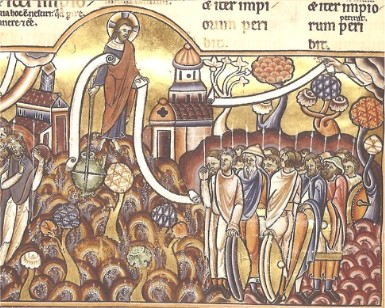A recent trip to Paris afforded me the chance to visit the National Library of France and acquire some inkjet reproductions of the Paris Eadwine Psalter. With a couple of exceptions, where the source is wrongly attributed to "the Canterbury Psalter," this material appears exclusively on the Internet on metahistory.org. Gaze and wonder!

Here is the same folio page shown in another view with color values adjusted to how it looks on microfilm—rather faded. I have not yet seen or handled the original MS so I do not know if its colors correspond to the gloriously preserved tones of the other version, or if this is a photoshop effect.
Scholars take the Sermon on the Mount for an illustration of Psalms 2, with allusion perhaps to verse 6, "Yet I have set my king upon the holy hill of Zion." In the scant literature I have been able to find on the Paris Eadwine Psalter, we are told that the lavish imagery of the MS is linked textually to the Old Testament books describing early events in the ecclesiastical story of humankind, mainly Genesis, and to the Psalms.
Lately we are hearing a lot of chatter about entheogens in the Old Testament, suggesting that Moses was "high" on Mount Sinai in ways that have not previously been considered. Benny Shannon seems to have kicked off the discussion, which involves a variation of the ecclesiastical mushroom cult proposed by Carl Ruck, a spinoff of the Allergo thesis (The Sacred Mushroom and the Cross), itself a spinoff of the Wasson thesis. Biblical Entheogens by Shannon, just out in March 2007, looks set to stir up a lot of controversy, not to mention loud protests from the Catholic Church and other defenders of ye ol'time relijun, salvationist-style. Paul Krassner has now jumped into the fray, as doubtless many others will do in short time.
I can only wonder how the revelations of the Paris Eadwine psalter will affect this debate. One possibility: since the Paris MS does not show amanitas, it may influence the prevalent tendency of Allergo, Ruck, and others to identify the fly-agaric as the entheogenic sacrament of choice among the Christian fold. In other words, it will support speculation that Christianity arose from a mushroom cult in Palestine. I strongly oppose this thesis.
Another possibility: close analysis of MS 8846 may suggest the survival of non-Christian cultic practices in Europe, late remnants of the Mysteries. If so, we will have to consider how Mystery cult revelations of the magic mushroom differed from the visionary states experienced by the ecclesiastical elite who, according to Ruck and others, kept the secret to themselves. I have some thoughts on this issue, to be presented in a look at the "Good Friday Experiment" coming up in The Psychonautic Adventure, G2.
Typically, the MS presents botanically pictured fungi of different species or genii along with a stylized version, the omphalos-bud, as I am calling it. Beneath the Savior are two botanical images, white (left) and brown (right), The brown mushroom sprouts from the same trunk as a blue omphalos-bud. In the upper right, under the angelic finger, two botanical specimens with their caps shredding sprout from the same trunk as a blue omphalos-bud. Just to the left, an ochre-colored omphalos-bud shares the trunk with a brown mushroom.
Did the visionary artists who conceived and oversaw the making of the psalter want to signify that both kinds of mushroom, literally represented and stylized, have the same source? They both come from the fruiting body of the mycelium. The blue-staining properties of the Psilocybe genus, indicative of tryptamines, are continually emphasized by the distinct bluish color of the trunks of the fruiting bodies. Elsewhere in the MS the botanically represented specimens display the same coloring.

Close up, the mushroom mountain has some intriguing details. The omphalos buds appear in three different types, (left to right): a composite of mouth-like nodules (recalling a venus fly-trap) , white mini-mushrooms in a lattice, and oblique, tree-shaped triangles. The mini-mushroom head is strikingly juxtaposed to the world globe at the tip of the long inverted cross held by the Savior. In Christian symbology, the fusion of cross and globe signifies the reign of dominator religion across the entire planet. Here, with the staff pointed down, it may carry another message. The ecclesiastical staff touches or almost merges with the mini-mushroom cluster—as if to say, "The true power of the world comes from here?"
The two lower mushrooms are clearly represented as botanical specimens, although the one on the right may incorporate other plant imagery. Otherwise, the mushroom mount is composed of clustered dark ringlets with some kind of white-flowered plant sprouting from them. These delicate plants have ochre buds or flame-like blossoms at the top. Botanical identification? I can't say. However, speaking as a psychonaut, I can attest that the ringlets resemble a sight I have frequently seen in visionary trance: supple conduits that wind endlessly into hyperspace. I take these conduits to be micro-tubular channels in the atmospheric body of Gaia. Paracelsus called them iliastri, threads of star-matter. They are closely associated with DNA which is structurally arranged by microtubules. The unidentified plants have three stems, recalling the triplets of DNA. Could the leaves on the plants be a way of picturing letters in the genetic code?

Christ tempted by an antlered shaman-devil in a mushroom grove.
Stay tuned for most on the Paris Eadwine Psalter in Savior, Hanged Man, Dancer. You ain't seen nuthin yet!
jll: May 2007 Andalucia


